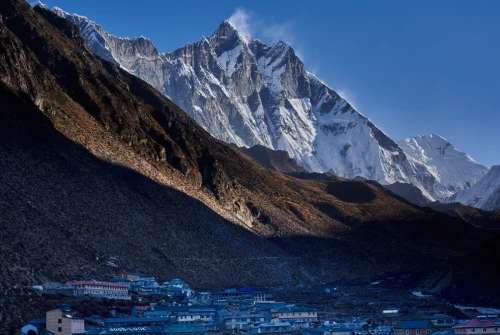Accommodation on the Gokyo Trek
Accommodation on the Gokyo Lakes trek mainly consists of basic mountain teahouses run by local Sherpa families, providing an authentic and budget-friendly lodging option for trekkers exploring the Nepal Himalayas. These teahouses offer a cozy, traditional experience with twin-sharing rooms, simple beds, thin mattresses, pillows, and warm blankets.
Most lodges have shared bathroom facilities, commonly squat toilets at higher elevations due to limited infrastructure. Some larger villages, such as Namche Bazaar and Gokyo, may offer attached bathrooms, but these are rare.
Hot showers are usually available in most villages and cost approximately USD 2 to 5 per use, with water heated via solar panels or gas systems. However, at high altitudes, showers can be limited because of water scarcity and colder temperatures.
Indoor heating is typically not available in bedrooms, so trekkers should prepare for cold nights, especially above 4,000 meters where temperatures can drop below freezing. Fortunately, most dining rooms are warmed by a traditional yak-dung stove, providing a welcoming communal space to relax after a long day of trekking.
It is essential to bring a quality sleeping bag rated for sub-zero temperatures, along with thermal layers and insulated clothing, to ensure comfort and warmth during the trek.
Booking accommodation in advance through a reputable guide or trekking company is recommended during peak trekking seasons to guarantee availability, as teahouses can fill up quickly on this popular Nepal trekking route.
Staying in teahouses on the Gokyo trek supports local Sherpa communities and offers a unique opportunity to immerse yourself in Nepali culture and Himalayan hospitality while enjoying spectacular mountain views and peaceful surroundings.
Meals on the Gokyo Lakes Trek
Food during the Gokyo Lakes trek is served primarily at local teahouses, offering hearty and nourishing meals designed to keep trekkers energized for long days of high-altitude trekking in the Nepal Himalayas. Although the menu options are more limited than in urban areas, the meals are surprisingly varied and freshly prepared using local ingredients.
Most teahouses operate on a fixed menu system, serving breakfast, lunch, and dinner from a selection of traditional Nepali and Tibetan dishes. The staple meal for trekkers is Dal Bhat, a nutritious and filling dish consisting of steamed rice, lentil soup, sautéed seasonal vegetables, and spicy pickles. Dal Bhat is highly favored because it provides essential carbohydrates and protein, plus offers unlimited refills, making it excellent value for hungry hikers.
Breakfast options typically include Tibetan bread, porridge, muesli, pancakes, and eggs prepared in different styles (fried, boiled, or scrambled). These are usually accompanied by hot beverages such as tea, coffee, or hot chocolate perfect for warming up before a day on the trail.
Lunch and dinner menus often feature a mix of fried noodles, spaghetti or pasta dishes, vegetable curries, Nepalese momos (steamed or fried dumplings), and fried rice. At higher elevations like Gokyo and beyond, food variety tends to decrease due to the difficulty of transporting supplies, which are carried by porters or yaks. Consequently, prices for snacks, soft drinks, and bottled water increase as you ascend.
Vegetarian meals are widely available and commonly preferred by trekkers above Namche Bazaar, where fresh meat is rare due to the lack of refrigeration. Vegan and gluten-free options can also be arranged in most teahouses, but it’s advisable to inform your guide or lodge owner ahead of time to accommodate specific dietary needs.
Hydration is crucial on the trek, and while bottled water is sold, it is often expensive and environmentally unfriendly. Most teahouses provide boiled water for a small fee, which is safer and more sustainable. Trekkers are encouraged to bring water purification tablets or portable filters to ensure a clean water supply throughout the journey.
Overall, the meals on the Gokyo Lakes trek offer a blend of traditional Nepali cuisine, practical nutrition, and local flavors, enhancing the cultural experience while providing the fuel needed to conquer the stunning Himalayan trails.
Weather and Temperature in Gokyo
The weather in the Gokyo region varies significantly with the seasons and altitude, influencing trekking conditions and comfort. Understanding these variations will help you prepare for the trek effectively.
Seasonal Weather Overview
Spring (March to May):
Spring is one of the best times to trek to Gokyo. Temperatures start to warm up, and rhododendron forests burst into vibrant red and pink blossoms. Days are generally clear and sunny, with daytime temperatures ranging from 10°C to 20°C (50°F to 68°F) at lower altitudes like Namche Bazaar. At Gokyo Lakes (around 4,700–5,000 meters), temperatures can drop to -5°C to 5°C (23°F to 41°F) during the day. Nights are cold, often dipping below freezing.
Summer/Monsoon (June to August):
The monsoon season brings heavy rainfall, cloudy skies, and increased risks of landslides and slippery trails. Daytime temperatures can reach 15°C to 22°C (59°F to 72°F) at lower elevations but are cooler higher up. Due to persistent clouds, views of the mountains are often obscured, and trekking is less popular during this period.
Autumn (September to November):
Autumn is the most popular trekking season due to stable weather and excellent visibility. Clear skies offer breathtaking panoramic views of Everest and the surrounding peaks. Temperatures during the day are mild, ranging between 10°C and 20°C (50°F to 68°F) at lower altitudes, while at Gokyo Lakes, daytime temperatures range from -2°C to 8°C (28°F to 46°F). Nights remain cold, frequently falling below freezing.
Winter (December to February):
Winter in Gokyo is harsh and challenging, with heavy snowfall and freezing temperatures. Daytime highs can hover around 0°C to 5°C (32°F to 41°F) at lower altitudes, but at Gokyo Lakes, temperatures often plunge to -15°C to -20°C (5°F to -4°F) or lower. Many tea houses close during this period, and trekking is recommended only for highly experienced adventurers with appropriate gear.
Daily Temperature Variations
Lower altitudes (2,800–3,500 meters, e.g., Namche Bazaar):
Higher altitudes (4,000–5,000 meters, e.g., Gokyo Lakes and Gokyo Ri):
Daytime: -5°C to 8°C (23°F to 46°F), depending on the season
Nighttime: -10°C to -20°C (14°F to -4°F), with temperatures dropping significantly after sunset
Weather Tips for the Gokyo Trek
Layering is key: Temperatures can vary widely within a day, so wear moisture-wicking base layers, insulating mid-layers, and a waterproof outer shell.
Prepare for cold nights: Even in warmer months, nighttime temperatures at high altitudes require a good-quality sleeping bag rated for sub-zero temperatures.
Sun protection: At high altitudes, UV radiation is stronger, so use sunscreen, sunglasses, and a hat.
Check forecasts regularly: Mountain weather can change quickly; always monitor local weather updates and be ready to adjust your plans accordingly.
Additional Nights in Kathmandu: Planning Your Pre- or Post-Trek Stay
If you arrive in Kathmandu ahead of your scheduled trek start date or decide to extend your stay after completing the Gokyo Lakes trek, it’s essential to plan and budget for extra nights of accommodation. Quality tourist-standard hotels in Kathmandu generally cost around USD 35-55 per night, and this rate usually includes a complimentary breakfast. Keep in mind that most Nepal trekking packages do not cover these additional hotel nights, meaning you will be responsible for booking and paying for these stays independently. Planning extra days in Kathmandu offers a great opportunity to explore the vibrant city, visit cultural landmarks like Boudhanath Stupa or Pashupatinath Temple, and acclimatize before heading into the mountains.
Permits Required for the Gokyo Trek
Trekking in the Everest region and visiting the stunning Gokyo Lakes requires obtaining two official permits for legal access. The first essential permit is the Sagarmatha National Park Entry Permit, which costs USD 30 per person. This permit allows trekkers to enter and explore the protected national park area surrounding Mount Everest.
The second required permit is the Khumbu Pasang Lhamu Rural Municipality Entry Permit, priced at USD 30 per person. This local permit grants access to the rural municipality that encompasses villages along the Gokyo trekking route.
If you book your trek through a professional trekking agency, these permits are usually included in the package price. However, if you plan to organize your trek independently, you will need to secure these permits yourself prior to starting the hike. Carrying valid permits is mandatory and enforced by local authorities to protect the natural environment and support sustainable tourism in the Everest region.
Trekking Costs and Budget Overview for the Gokyo Lakes Trek
The Gokyo Lakes trek is considered moderately priced compared to other popular Himalayan trekking routes in Nepal. For most travelers opting for a guided or group trek, the total cost typically ranges between USD 1,000 and USD 1,400 per person. One of the major expenses is the round-trip flight from Kathmandu to Lukla, which averages around USD 425.
Accommodation along the trail is provided by local mountain teahouses, with prices varying between USD 5 and USD 15 per night depending on the altitude and available amenities. Daily meal costs usually fall between USD 20 and USD 30 for three meals, featuring nutritious and energizing local cuisine.
Hiring a licensed trekking guide is highly recommended for safety and local expertise, with rates generally around USD 25 to USD 30 per day. Additionally, many trekkers hire a porter to carry heavy gear, which costs approximately USD 15 to USD 25 per day and significantly eases the trekking experience.
While budgeting, it’s important to factor in extra trail expenses such as snacks, hot showers (which often cost a small fee), charging electronic devices, and purchasing Wi-Fi access at tea houses. These small costs add up but are essential for comfort and connectivity during your trek.
Preventing Altitude Sickness on the Gokyo Trek
Since Gokyo Ri rises to an altitude of over 5,300 meters (17,500 feet), altitude sickness or Acute Mountain Sickness (AMS) poses a significant risk for trekkers. Preventing AMS is crucial for a safe and enjoyable trek in the high Himalayas.
To minimize the risk, it’s essential to ascend gradually, ideally limiting your daily elevation gain to no more than 500 meters above 3,000 meters. Staying well-hydrated by drinking 3 to 4 liters of water daily helps your body adjust to the thinner air. Your trekking itinerary should include acclimatization days, especially at popular stops like Namche Bazaar and Dole, where your body can recover before ascending further.
Recognizing the early signs of altitude sickness is vital. Symptoms such as headaches, dizziness, fatigue, and nausea indicate that your body is struggling to acclimatize. If symptoms worsen, immediate descent is necessary to avoid severe complications. Trekking with an experienced licensed guide ensures that proper acclimatization protocols are followed and that medical assistance is available if needed.
By taking these precautions seriously, you can reduce the chances of altitude sickness and enjoy the breathtaking views and unique experiences of the Gokyo Lakes trek safely.
Travel Insurance for the Gokyo Trek
Travel insurance is mandatory for anyone trekking the Gokyo Lakes route in Nepal’s Everest region. Due to the remote and high-altitude nature of this trek, having comprehensive insurance is critical for your safety and peace of mind.
Your travel insurance policy should specifically cover high-altitude trekking up to at least 6,000 meters (19,685 feet) to ensure you are protected against altitude-related illnesses and emergencies. Additionally, coverage for emergency helicopter evacuation is vital, as urgent medical evacuations from Gokyo or surrounding areas can be extremely costly and complicated.
Medical treatment expenses should also be included, as healthcare in remote mountain regions can be expensive. Finally, given the frequent flight delays and cancellations common to the Lukla airport often caused by unpredictable weather trip cancellation and delay insurance is highly recommended.
Without adequate travel insurance, trekkers risk facing exorbitant out-of-pocket costs in case of emergencies, which can severely impact your trekking experience and budget. Investing in a reliable insurance policy is a smart and responsible step before embarking on the breathtaking but challenging Gokyo Lakes trek.
Trail Conditions and Safety on the Gokyo Lakes Trek
The Gokyo Lakes trekking trail is generally well-marked and safe, guiding trekkers through picturesque villages such as Namche Bazaar, Dole, Machhermo, and finally Gokyo itself. The paths are clearly defined, making navigation straightforward for hikers of moderate experience.
During the winter months, the trail can become icy, especially at higher elevations, increasing the risk of slips and falls. To maintain safety on these slippery sections, trekking with microspikes or traction cleats attached to your boots is highly recommended.
For trekkers who choose to include the Cho La Pass crossing, a popular but more challenging extension of the trek, extra caution is essential. This route involves technical terrain including glacier crossings and potential snowfields, which require specialized equipment and experience. Therefore, attempting Cho La Pass should only be done with the support of a trained guide who can navigate the difficult sections safely.
Overall, following proper safety precautions, staying on marked trails, and listening to your guide’s advice will help ensure a rewarding and secure trekking experience in the stunning Everest region.
Trekking Solo or in a Group
Recent trekking regulations in Nepal’s Everest region now require all trekkers to be accompanied by a licensed guide when trekking in remote areas like the Gokyo Lakes. Solo trekking without a guide is no longer permitted, ensuring greater safety and support for visitors.
If you prefer a social and budget-friendly experience, joining a group trek is an excellent choice. Group treks offer the chance to meet fellow adventurers from around the world while sharing costs for guides, porters, and accommodations. This option is ideal for solo travelers looking for companionship and an organized itinerary.
For those seeking a more flexible and personalized experience, a private guided trek is available. With a private guide, you can customize your schedule, pace, and route while benefiting from expert local knowledge and safety assistance.
If you want to trek independently, hiring a licensed guide for solo trekking is the safest and legal option. A guide handles logistics, permits, and ensures proper acclimatization, making your solo journey both enjoyable and secure.
No matter which option you choose, trekking with a licensed guide enhances safety, cultural insight, and support throughout the Gokyo Lakes trek.
Tipping Etiquette in Nepal for Trekking
Tipping is an important part of the trekking culture in Nepal and serves as a meaningful way to express gratitude to your guide and porter for their hard work and support throughout the trek. On a multi-day trek like the Gokyo Lakes trek, it is customary to tip your guide between USD 100 and 150 per trek and your porter between USD 60 and 100 per trek.
While tipping is not mandatory, it is highly appreciated and often seen as a reflection of the quality of service provided. Many trekkers find that tipping helps ensure motivated and attentive service, supporting the livelihoods of local trekking staff.
If you enjoyed your experience and felt well-supported, consider tipping generously. Conversely, if tipping isn’t feasible, guides and porters understand, so never feel pressured.
Internet Access and Charging on the Gokyo Lakes Trek
Wi-Fi connectivity is available at some teahouses along the Gokyo Lakes trekking route, particularly in larger villages like Namche Bazaar, Dole, and Gokyo. However, the internet speed is often slow and can be unreliable, especially during bad weather or peak trekking seasons.
Most lodges charge a fee ranging from USD 2 to USD 5 per hour for charging electronic devices such as smartphones, cameras, and power banks. To stay connected and keep your devices powered throughout the trek, it’s highly recommended to carry a portable power bank or a solar charger.
Additionally, because cold temperatures at high altitudes can drain batteries faster, make sure to keep your electronics warm at night storing them inside your sleeping bag or close to your body helps preserve battery life.
Staying connected during the trek is possible but limited, so plan accordingly and use internet access sparingly.
Gokyo Lakes Trek vs. Everest Base Camp Trek
Both the Gokyo Lakes trek and the Everest Base Camp (EBC) trek provide breathtaking Himalayan adventures, but they differ in several key ways. The Gokyo Lakes trek is notably quieter and less crowded, offering trekkers a chance to experience more serene and pristine natural surroundings.
One of the highlights of the Gokyo trek is the spectacular series of turquoise Gokyo Lakes set against the backdrop of towering peaks. Additionally, trekkers witness the impressive Ngozumpa Glacier, which is the longest glacier in Nepal and a major natural attraction on this route. From the summit of Gokyo Ri (5,357 meters), you’ll be rewarded with panoramic, unobstructed views of iconic Himalayan giants like Mount Everest, Lhotse, Makalu, and Cho Oyu.
Compared to the more commercialized and busier Everest Base Camp trek, the Gokyo route offers a unique blend of tranquility, spectacular high-altitude lakes, and fewer tourists. It’s an ideal alternative for trekkers seeking solitude, stunning natural beauty, and a memorable off-the-beaten-path experience while still enjoying majestic views of the Everest region.
Emergency Preparedness on the Gokyo Lakes Trek
Health and safety are top priorities during the Gokyo Lakes trek. In case of illness or injury, helicopter evacuation services are available from most villages along the route, including Gokyo. It’s essential to inform your guide immediately if you start feeling unwell so that prompt action can be taken.
Make sure to carry important items in your daypack at all times, including your travel insurance card, a copy of your passport, altitude sickness medication like Diamox, and a basic first aid kit. Being prepared can make a critical difference in managing emergencies efficiently while trekking in this remote high-altitude region.
What to Pack for the Gokyo Lakes Trek
Packing smart is key to a successful and comfortable Gokyo Lakes trek, as weather conditions in the Everest region can vary dramatically throughout the day and across altitudes.
Footwear is crucial—bring sturdy, waterproof hiking boots with good ankle support to tackle rocky and sometimes slippery trails. For clothing, layer up with thermal base layers, a warm fleece jacket, and a high-quality down jacket for insulation during cold mornings and evenings. A waterproof and windproof shell jacket is essential to protect you from rain, snow, and wind gusts common in the mountains.
Accessories such as a warm hat and insulated gloves will keep extremities comfortable in freezing temperatures, especially when you reach higher elevations like Gokyo Ri. Don’t forget UV-protection sunglasses and high-SPF sunscreen to shield your skin and eyes from intense sun exposure at altitude.
Stay hydrated by carrying reusable water bottles, and to keep warm during the night, pack a sleeping bag rated to –20°C most teahouses provide blankets, but temperatures can drop significantly.
Additional trekking essentials include trekking poles to reduce knee strain on steep descents and ascents, a reliable headlamp for early starts or late arrivals, and a power bank to keep your electronics charged in remote areas with limited electricity.
For health and hygiene, carry a basic first-aid kit tailored to altitude trekking, and ensure you have water purification tablets or a portable water filter to safely drink from local water sources.
By packing these essentials, you’ll be well-prepared to enjoy the breathtaking beauty and adventure of the Gokyo Lakes trek with comfort and safety.

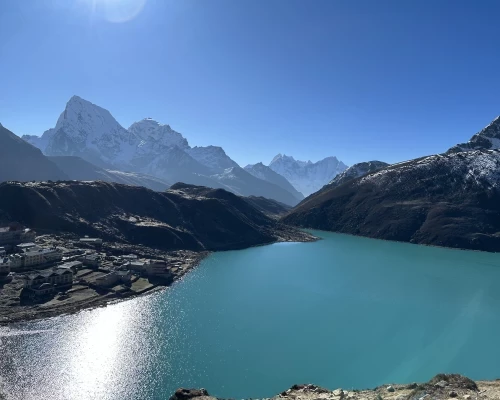
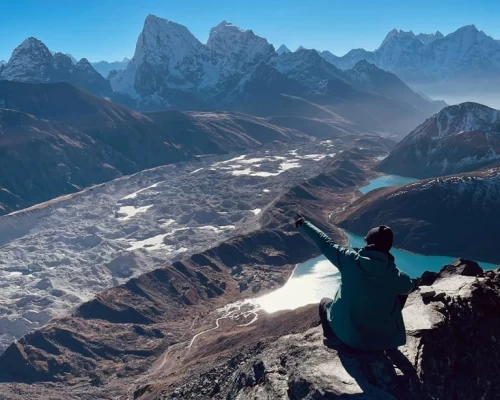
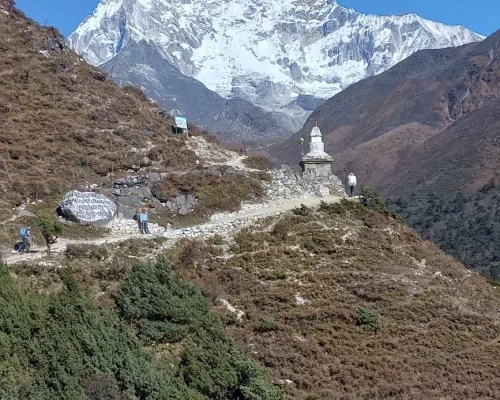
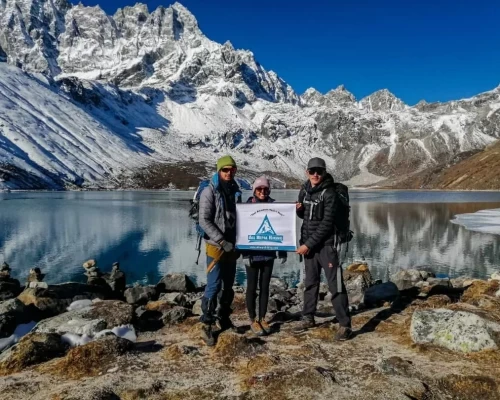


 based on 9 reviews
based on 9 reviews